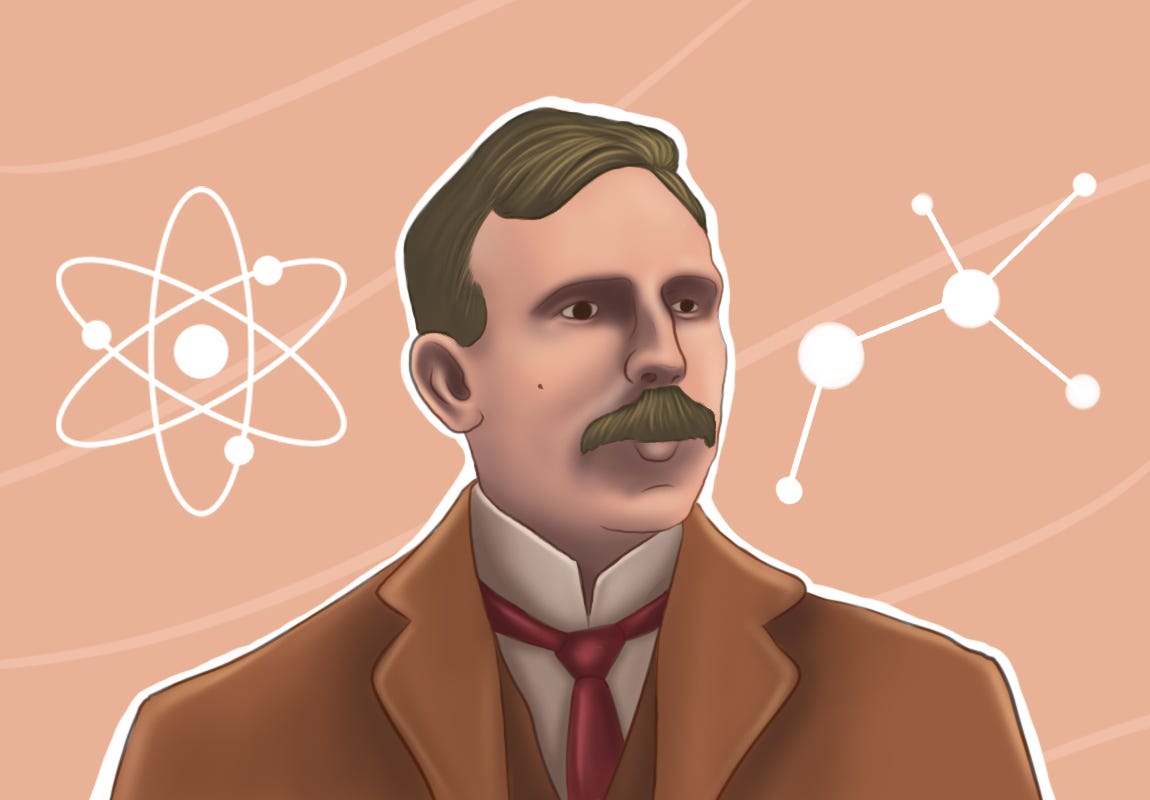On the patio of the University of Cambridge’s Cavendish Laboratory, Ernest Rutherford was like an ‘alien’ to other students, the student who came to pursue postgraduation without any degree from Cambridge! Ernest Rutherford was the first among those students who were allowed to do research at Cambridge despite having a bachelor’s degree from another university. That was just the beginning of Ernest Rutherford’s illustrious career. Ernest Rutherford, the Father of Nuclear Physics, was reborn at the Cavendish laboratory.
Great experimentalist
Ernest, 1st Baron Rutherford of Nelson or Lord Rutherford alias Ernest Rutherford, was a New Zealand physicist born on August 30, 1871. He is considered the greatest experimentalist after Michael Faraday since Rutherford conducted several experiments in the field of radioactivity and put forward many new concepts regarding the nuclear atom.
Ernest Rutherford was born to James Rutherford and Martha Thompson in New Zealand. The family had moved from Scotland before his birth. Ernest, the fourth child of the couple, attended the free state school in 1886. Then he attended Nelson Collegiate School, which was a private secondary school there. Ernest was a brilliant student who excelled in mathematics and science.
Rutherford earned a scholarship in 1890 and it took him to Canterbury College in Christchurch, which was one of the four campuses of the University of New Zealand. Though it was a small campus with less than 300 students, Rutherford was fortunate enough to learn under excellent professors there. His passion for scientific investigation was ignited there.
Initially, he had a BA degree and then he earned postgraduate degrees in physical science, mathematics, and mathematical physics. He was interested in doing independent research. His research in high-frequency electrical discharge such as capacitors to magnetise iron earned him a BS degree, too, in 1894. It was during this period that he met his love Mary Newton, whom he married in 1900.
To Cambridge
In 1895, Rutherford won a scholarship and decided to continue his studies at the Cavendish Laboratory of the University of Cambridge under British physicist J J Thomson. It was the first time Cambridge was open to graduate students from other universities doing research at their own facilities.
Rutherford’s research skills won him a professorship at McGill University, Montreal, and this helped him access better equipped laboratories in the West.
J J Thomson invited Rutherford to collaborate in an investigation of the way in which X-rays changed the conductivity of gases. This resulted in the penning of a classic paper on ionisation in atoms or molecules, that is atoms broke into negative and positive ions and the charged particles were attracted to electrodes of opposite poles.
Rutherford was one of the pioneers who studied radioactivity and atoms. He discovered that there are two types of radiation while experimenting with uranium and called them alpha and beta particles. Rutherford’s most famous experiment – the gold foil experiment – led him to formulate the Rutherford model of the atom- a small charged nucleus, containing much of the atom's mass, was orbited by low-mass electrons. He also found out that the atomic nucleus is positively charged and surrounded at a distance by the negatively charged electrons (earlier found by J J Thomson).
Extended research
Rutherford’s research skills won him a professorship at McGill University, Montreal, and this helped him access better equipped laboratories in the West. He turned his attention to radioactive bodies and particularly the emission of alpha rays and radium emanation. With R B Owens, he discovered a new noble gas, an isotope of Radon, which was later known as Thoron. In 1907, Rutherford was offered a Chair at the University of Manchester. The next year, in 1908, he was awarded the Nobel Prize in Chemistry.
Rutherford was knighted in 1914 and was appointed to the Order of Merit in 1925.
During his last year at Manchester in 1919, he discovered that the nuclei of certain light elements such as Nitrogen could be disintegrated by the impact of energetic alpha particles coming from the radioactive source.
Recognitions
Rutherford was knighted in 1914 and was appointed to the Order of Merit in 1925. In 1931, he was chosen as the First Baron Rutherford of Nelson, New Zealand, and Cambridge. He was elected as a Fellow of the Royal Society in 1903 and was its President from 1925 to 1930.
Rutherford married Mary Newton in 1900. They had a daughter, Eileen, who married physicist R H Fowler.
Ernest Rutherford passed away in Cambridge on October 19, 1937. His ashes were buried in the nave of Westminster Abbey, nearby Sir Isaac Newton’s tomb. The chemical element Rutherfordium (element 104) was named after Rutherford in 1997.
Rutherford was thus an inspiring leader of the Cavendish Laboratory. He also steered numerous future Nobel Prize winners like James Chadwick, John Cockcroft and Ernest Walton towards their great achievements.
Now put on your thinking hats and think about the following questions for a couple of minutes.
How would you describe the Rutherford model of the atom to your students?
How would you describe the contributions of Ernest Rutherford in the field of nuclear physics?
Write down your thoughts and discuss them with your students, children, and your colleagues. Listen to their views and compare them with your own. As you listen to others, note how similar or different your views are to others’.
Thank you for listening. Subscribe to The Scando Review on thescandoreview.com.
Happy Teaching!














Ernest Rutherford: ‘Father of Nuclear Physics’